Zermatt's Mountaineers' Cemetery
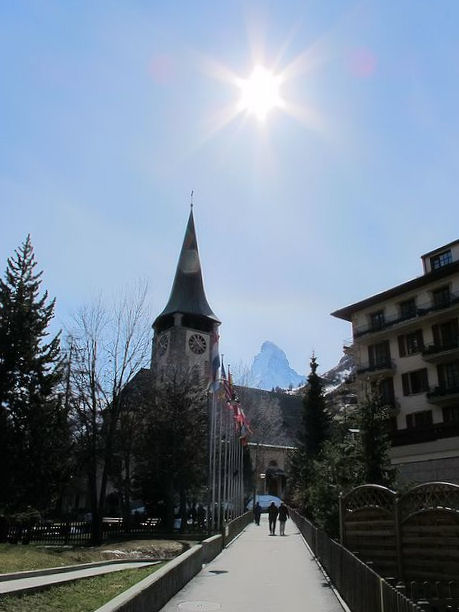
Surrounded by 38 peaks that stretch up above a dizzying 4000m, Zermatt has been visited by mountaineers from all around the world ever since the birth of Alpinism in the mid nineteenth century. The mountain that dominates the town, however, is the beautiful Matterhorn (4478m).
Nowadays more than 3,000 alpinists climb the Matterhorn every year, several times more than all the other 37 summits combined. During the summer months as many as 150 climbers or more attempt to reach the summit every day. The majority of climbers abandon their endeavours for various reasons, and an annual average of 1200 need to be rescued. Around 15 climbers a year - over 500 in total - set out but do not return alive, mostly through falls on the descent. Some 10% of these tumble to their deaths on the glacier below the Matterhorn and their bodies are never recovered.
The mountain is not considered a particularly difficult climb - the popular Hörnli ridge route on the north-east is graded 5.4. However it takes several hours to reach the summit and most climbers set out before dawn from the Hörnli Hut or the Berghaus Matterhorn (at 3260m) to ensure they complete the climb before nightfall. During busy periods the dangers posed by congestion on narrow sections adds to the risks from rock falls, exhaustion and altitude sickness. The weather is also notoriously fickle around the Matterhorn, and visibility and overall conditions can change very quickly for the worse.
The graves of many of those who died climbing the Valais peaks now lie at the foot of the mountain, in Zermatt. Many have no more story than their headstone tells...
Alfred Spratt
 - 1868.jpg)
Alfred Spratt of Hampstead died in 1868, aged roughly 34.
Arthur Gillian Emery
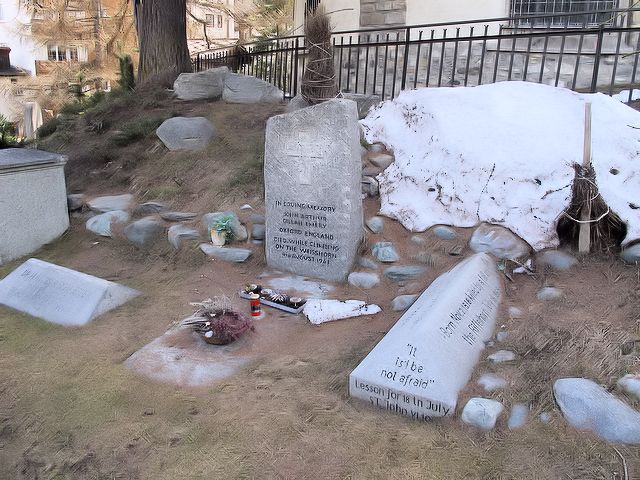
Emery died on the Weisshorn in 1963. To the right of his headstone is the grave of A K (Knyvet) Wilson who died aged 26 on the Riffelhorn in 1865, just days after the first fatal ascent of the Matterhorn, apparently after trying to climb the mountain solo on his return from climbing it with some companions. The New York Times reported at the time he was "a Fellow of Trinity College, Cambridge, and a Master of Rugby School. He appears to be most deeply regretted as an able master, a cheerful and affectionate friend, and a man of great vigor and independence of character".
Charles Richard Earnshaw
 - Descending Obergabelhorn.jpg)
The "dearly loved younger son of John & Vinnie Earnshaw of Baildon, England", was born 20 years to the day before me and lost his promising life one July day in 1958 aged 22 whilst descending the Obergabelhorn. Alongside are the graves of Eduoard de Gigord, Yves Guibert, Pierre Langlois and Pierre Le Bec, who died on the Breithorn in 1928, and Erkenwald B Mooring Aldridge (1882-1964).
Colin Henry Taylor
 - South Face of Obergabelhorn 1974.jpg)
Taylor died on the South Face of Obergabelhorn in 1974, aged 37. Alongside are the graves of Edwin Jeremy Bailey from Batley (1949-1970) and Richard Ackermann (1933-1972).
Croz, Douglas, Hudson & Hadow
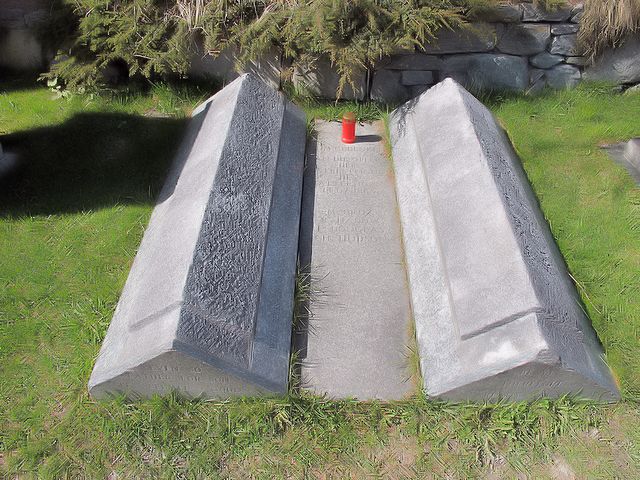
Michel Auguste Croz, from Chamonix, was a distinguished mountain guide and the first to ascend many mountains in the western Alps, although he is chiefly remembered for his death following the first ever ascent of the Matterhorn in a team led by Edward Whymper on 14th July 1865. Lord Francis Douglas, Charles Hudson, Douglas Hadow and Croz fell to their deaths whilst descending the Matterhorn but Whymper, the guide Peter Taugwalder and Taugwalder's son, also called Peter, survived. Douglas's body has never been found, and is presumably frozen in time, forever 18 years old in his icy resting place. At the time many people suspected foul play in the deaths of the four climbers, since the rope they were on was attached to the surviving climbers but had apparently snapped, sparing the lives of their companions. Whymper later wrote in his 1871 book, Scrambles Amongst the Alps: "Every night, do you understand, I see my comrades of the Matterhorn slipping on their backs, their arms outstretched, one after the other, in perfect order at equal distances — Croz the guide, first, then Hadow, then Hudson and lastly Douglas."
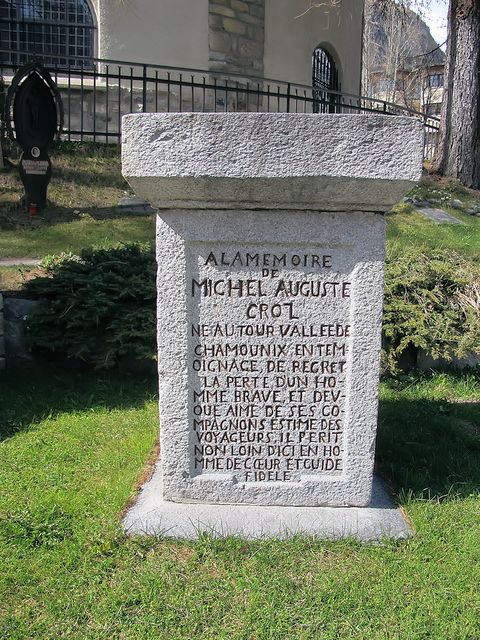
David Robinson
 - descending Matterhorn by Hornli Ridge 1976.jpg)
24 year old Robinson attempted the most difficult face of the Matterhorn, the North, at its most bleak in December 1976, but ironically (as is often the case with the Matterhorn) it was the descent that proved fatal.
Donald Stephen Williams
 - Breithorn 1975 I Chose to.jpg)
The headstone reads "I chose to climb". It must have been an adventure for the teenager from New York to come to Europe to climb Alpine peaks, but sadly it was to be his last. He died, aged 17 in 1975 on the Breithorn.
Freda Currant
 - Matterhorn 1936.jpg)
The headstone claims that 24 year old Freda passed into a fuller life from the Matterhorn at dawn on August 6th 1936. Freda, a physiotherapist from Luton, met her death while climbing with a party of four English friends on the Matterhorn, where George Restall, of Solihull, and his Swiss guide, had died only the day before. She died within earshot of a search party which had just come upon the body of the guide. The Birmingham Post & Mail at the time reported that "As the search party was about to lift the body of the guide, they heard cries for help from the foot of the mountain. An Englishman shouted that his companion had just fallen. The party went immediately to the spot and found the body of the young Englishwoman. The search for the body of Mr George Restall continues."
The first woman to climb the Matterhorn was one Lucy Walker in 1871, but sadly many other women have joined Freda amongst a fatal sisterhood of female climbers who died around Zermatt. Another was the famous Alpinist and writer Eleonore Noll-Hasenclever (1880 – 1925) who said that “The happiness that the mountains give their loyal followers is a very special thing; it cannot be forced. But anyone who feels this happiness will be forever under the spell of the mountains. They make him infinitely rich, and I also believe that he can never be completely poor again!” These words describe for Eleonore the attraction of the Bishorn, ironically the mountain that claimed her life. Her gravestone is also in the Mountaineers’ Cemetery in Zermatt. An earlier fatality was Mildred Aline Bell who died descending the Matterhorn on July 25th, 1901, aged 20, and who is now buried in the Churchyard at the Parish Church of St John-at-Hampstead. There is a memorial to her inside the church. She had been roped with three other companions, two of whom miraculously survived the fall, remarkably since the climbers fell a significant distance and the body of Mildred was reportedly "horribly mutilated". The other fatality was 41 year old Dr Robert Black.Geoffrey Christopher Gregson
 - Dent Blanche 1936.jpg)
Gregson fell 1000m whilst nearing the summit of the Dent Blanche peak in 1936, aged 22.
Herbert & Anni Braum
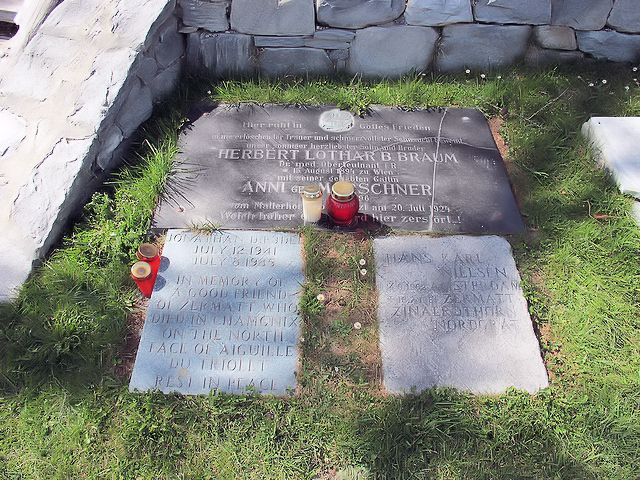
Herbert Lothar B. Braum (29) & his wife, Anni Marschner (27) died whilst climbing on their honeymoon. He was a physician and military reservist, a son and brother with a heart of sunshine according to the inscription. The last line on the gravestone is a German corruption of Ophelia's lament from Hamlet Act 3 Scene 1 "O what a noble mind is here o'erthrown!". Other graves in the picture are for Jonathan D Ryder (43) who died in Chamonix in 1985 and Hans Karl Nielson (18) who died on the Zinal Rothorn in 1981.
Hermann Hotz
 - Weisshorn 1933.jpg)
The grave states that Hermann was born in Simla, India and died 53 years later in 1933 on the Weisshorn. The Himalayan Club reported that he was employed as Director and Engineer of the Rawalpindi Electric Power Company and had been a keen mountaineer since boyhood and had considerable experience in both the Swiss Alps and the Himalayas. In 1933, with Franz Lochmatter, he climbed the Tschingelhorn, Aletschorn, Matterhorn, Dent Blanche, and the Weisshorn, being killed with Lochmatter while descending the last-named peak on the 17th August 1933. It was apparently always his wish to be taken suddenly in his beloved mountains and to be buried in the snow. To the right or his grave lie Hugh Desmond Bullock (27) and Daniel Alan Hanson (25) who died on Pollux in 1949. Behind are the graves of Gigord party, Erinwald B Mooring, Sandro Wulff (30) - 2002, Rude & Hans Gallman - 1941 and Eduard von Grote - 1859
Irmgard Schiess & Victor de Beauclair
, Victor de Beauclair (55) - Matterhorn 1929.jpg)
These two climbers died together on 15th August 1929. Both were from Freiburg Im Breisgau but she was born in Hannover and he in Cantaglio, Brazil. I wonder whether they were they friends or simply shared a desire to climb the Matterhorn. Perhaps they were lovers? The angle of the gravestones lends a poignancy that suggests an intimacy.
John Gregory Cooper & Rupert James Champion
 & Rupert James Champion (19) -.jpg)
The Glasgow Herald reported on July 18th, 1959 that Cooper and Champion were in a party of four Cambridge students, two of whom - Ian Gibson and Julian Williams - survived the aborted ascent. Gibson reported that he and Williams were roped together about 30 ft behind the other pair. "We had reached the Z'mutt Ridge when one of the other two slipped in the new snow and fell, dragging the other with him," Gibson said. "It seems that one of them had not tied himself securely to the rocks while the other went forward". The pair fell about 1000m to the Tiefenmatten glacier, where their bodies were recovered by helicopter the following day. The headstone behind their grave is for Omerville Hastings (1877-1967) and Bessie Hastings (1882-1958).
Jonathan Henry Conville
 - Matterhorn 1979.jpg)
Conville fell from the North Face of the Matterhorn on 29th December 1979, when the sheer bleakness of the mountain must have made it as hard an ascent as you can imagine. His inscription reads: "Let me go climb these virgin snows, Leave the dark stain of man behind. Let me give adventure and heaven knows Grateful shall be my quiet mind". Alongside his grave is that of Also Hubert Jaritz who died on the Monte Rosa in 1925.
Peter-Roderick Phillips
 - Matterhorn.jpg)
Peter-Roderick Phillips, born in 1935 died on the Matterhorn in 1955.
Vernon Allen Crawford
 from Denver, Colorado - Matterhorn 1955.jpg)
Crawford was was from Denver, Colorado and died on the Matterhorn in 1955, aged 24. The inscription reads "I will lift up mine eyes unto the hills" - Psalm 121.
Vernon Charles Strange
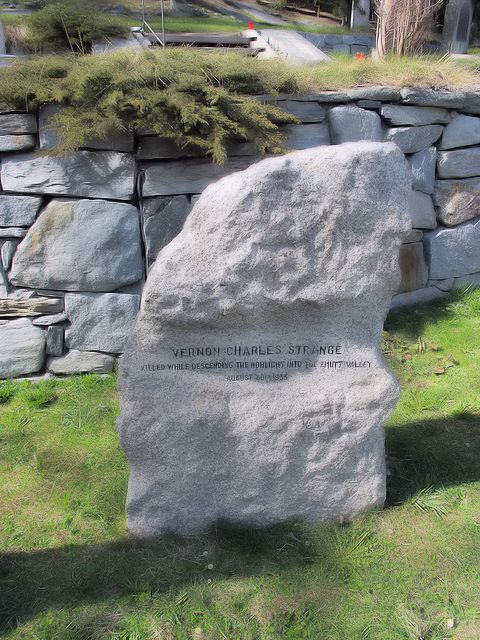
Strange, from London, was probably 40 when he fell to his death on 30th August 1933 descending Hohlicht into the Zmutt Valley. He is mentioned as having been made an army officer in the Devonshire Regiment right at the outset of the First World War (and was subsequently promoted to at least acting Captain), so did remarkably well to survive through until the conclusion. His luck let him down 19 years later.
William Andrew Bell (23), James Ian Campbell McKean (22), James Ogilvie (23)
, James Ian Campbell McKean (22), James Ogilvie.jpg)
Friends from Oxford, they died together on the Matterhorn in 1948. Their insciption reads "non enim accessistis ad tractabilem montem" from Hebrews 12:18 which translates as "For you are not come to a mountain that might be touched". Also remembered on their grave is an unknown climber whose body was found on the Matterhorn, presumably at the same time as the search for the three friends. William Andrew Bell was a distinguished editor and poet whose published works are Elegies (1945) and Mountains Beneath the Horizon (1950).
------------------
Graves Not Shown Here
David Owen Hughes died in a fall from the Hornli Ridge of the Matterhorn in August 1984 while descending from the summit. Apparently he slipped on a relatively easy section after he and his companion had decided to unrope. His body was not found until 10 days later. An Englishman living in South Africa, he was 47 and left behind a wife and two daughters aged 17 and 12. He is buried in the cemetery at Zermatt and there is a plaque in the English church there in his memory. Dr John Emery died descending the Weisshorn, after having successfully scaled the Schalligrat, on August 4th, 1963, aged twenty-nine. Close to safe ground, he and his American companion, David Sowles, were roped together and both fell to their deaths. John was no stranger to disaster. An Oxford half-Blue in fencing, he lost his fingers and toes from frostbite on the fatal 1957 Oxford University Haramosh Expedition, documented in Ralph Barker's book, The Last Blue Mountain. Undeterred he continued to climb, saying once "I had no hesitation in wanting to climb again; I had always considered that anyone who stops climbing after a mountain accident, unless compelled to do so by physical incapacity, has no business to be climbing in the first place, because he has either failed initially to consider the full implications of mountaineering, or else has wilfully blinded himself to them". Emery is buried in Zermatt, and left behind a wife and daughter.There are many other graves of climbers in the cemetery, which lies in front of the parish church of St Mauritius on Kirchstrasse, Zermatt. Many climbers were buried in the cemetery of the Anglican church of St. Peter's and in the Catholic cemetery but the gemeinde decided to restore the gravestones and to exhibit them outside St Mauritius. There is also a memorial in the Catholic cemetery for the Zermatt mountain guides who were killed in accidents.